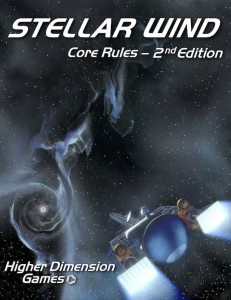Stellar Wind
Stellar Wind is a complete role-playing game published by Higher Dimension Games.
By Fred Goff

Learn more about Stellar Wind here
Purchase Stellar Wind here
Find other Stellar Wind products here
Welcome to the forty-fourth Designer’s Diary, a column where designers are given the opportunity to take readers on an in-depth ride through the design and development process of their system, setting, or product. If you’d like to share your product in the Designer’s Diary column, send a message to aaron@roleplayerschronicle.com.
Designer’s Description
Stellar Wind is a traditional Science Fiction Role-Playing Game inspired by the Golden Age of science fiction. The Golden Age was a time of future optimism. While humans would always be human with all their flaws, technology would bring about a better future, and humanity felt a manifest destiny toward space travel and exploration. Stellar Wind tries to capture that optimism while still allowing for all the human elements that makes for fun role-playing.
Purpose
I felt the science fiction role-playing space was lacking a game that was true to what I loved about science fiction: an optimistic dynamic future, a love of technology, and a faithfulness to science. I wanted a game that brought that same experience to gaming.
Influences
My largest influences were the writings of the Golden Age authors (Hal Clement, Isaac Asimov, Poul Anderson, Robert Heinlein, etc.) as well as the best science fiction book ever written: The Mote in God’s Eye.
Research
There was actually quite a lot of research involved in the game. Because Stellar Wind is in the genre of “hard” science fiction, I had to make sure the things I placed in the game were scientifically accurate. I spent a lot of time on the Internet researching current theories on laser weaponry, spacecraft propulsion systems, world formation and biology. My challenge was to make a game that was scientifically accurate without having it devolve into a textbook on physics.
A good example of how scientific accuracy differentiates Stellar Wind from other SFRPGs is in some of the weaponry. Look up any other SFRPG, and you’ll find entries for laser pistol, laser rifle, laser carbine, etc. The problem is, that’s not how laser weapons will develop. Pistols, rifles, carbines and the like are descriptions of a weapon designed to fire a slug. Lasers operate on a completely different principle. So, in Stellar Wind, you don’t have laser pistols or laser rifles. You instead have pulse lasers in various power ranges (5kW, 10kW, etc.).
Art Direction
Like most independent games, Stellar Wind operates on a very small budget, so finding suitable artwork was a challenge. The solution that eventually worked for me was to use a combination of public domain and creative commons artwork along with original artwork created using 3D modeling software.
Gaming Experience
Stellar Wind is intended to provide players with a “bright” future gaming experience, where the human condition is still understandable. It’s neither utopian, nor dystopian in nature, but assumes humanity will be similar to the way it is today, only with expanded capabilities and experiences allowed by advanced technology and space flight.
This lets players identify with their characters and tell stories that are simultaneously fantastic and believable. And great stories are what good gaming is all about.
Comparison
Stellar Wind is probably most similar to the Traveller series of games, but does have some notable differences. Skills are less dependent on profession and skill levels have more meaning, and space travel is more realistic and less “ocean liner in space.”
Development Process
The underlying theme in all of my development process is fun. Games are about having fun, so the first thing I do is try to figure out what would be fun. The second thing a game has to be is different. There has to be something different about your game than everyone else’s or there’s no reason for someone to buy yours instead of everyone else’s.
The fun part I figure out based on what I think would be fun. If I’m not writing or designing something I think is fun, I’m not going to be able to make a very good product because my heart won’t be in it.
Making the game different is also easy; as gamers there’s always something we don’t like about whatever game we happen to be playing. When I designed Stellar Wind, that’s what made my game different: all the stuff I didn’t like in other SFRPGs I played. My game is different because I “fixed” those things I didn’t like.
Once I have those two fundamentals down, the rest becomes mechanics. I chunk out the things I think are fun in the game (for example, realistic space travel), then I come up with the rules that need to support that fun thing (propulsion systems, etc.). Then I flesh out the writing, put together the tables and create or pick the artwork and do the layout. These last two are very important, because not only should a game be fun to play, the rulebook should also be fun to read and look at. It’s one of the reasons that both my first and second edition rulebooks include a short story that weaves through the book, introducing each chapter. I’ve had more than one fan say the first thing he did was flip to each chapter to see how the story turned out.


